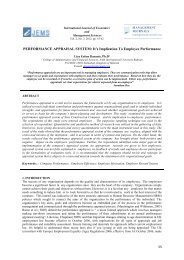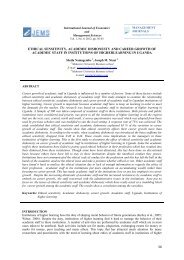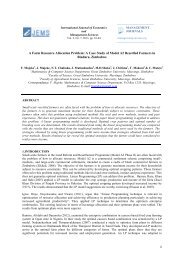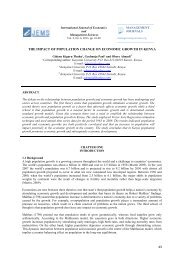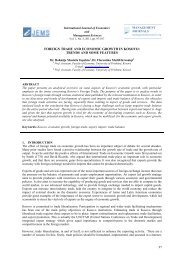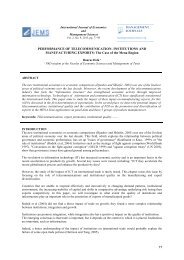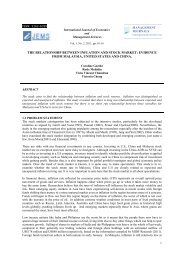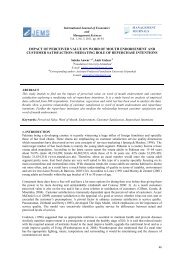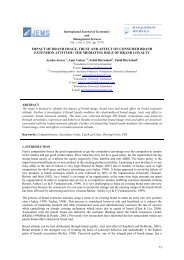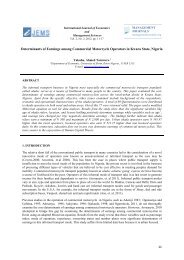effect of financial liberalization on economic growth in
effect of financial liberalization on economic growth in
effect of financial liberalization on economic growth in
You also want an ePaper? Increase the reach of your titles
YUMPU automatically turns print PDFs into web optimized ePapers that Google loves.
http//: www.managementjournals.org<br />
Internati<strong>on</strong>al Journal <str<strong>on</strong>g>of</str<strong>on</strong>g> Ec<strong>on</strong>omics and Management Sciences Vol. 1, No. 12, 2012, pp. 16-28<br />
signed, we chose the equati<strong>on</strong> with the lowest log likelihood ratio and if negative signed, we chose the highest<br />
log likelihood ratio at absolute term.<br />
From the Johansen co-<strong>in</strong>tegrati<strong>on</strong> result, all five log likelihood ratio <str<strong>on</strong>g>of</str<strong>on</strong>g> the respective co-<strong>in</strong>tegrat<strong>in</strong>g equati<strong>on</strong>s<br />
are positively signed. Therefore, the lowest log likelihood ratio is chosen. The lowest log likelihood ratio is<br />
72.76462 and its corresp<strong>on</strong>d<strong>in</strong>g co-<strong>in</strong>tegrat<strong>in</strong>g equati<strong>on</strong> is stated below;<br />
GDP = 6.235907 LR * – 0.882132 EXR * + 0.549840 INF * – 3.667020 FD * – 1.093489 DOP * – 20.67370<br />
(0.52950) (0.05069) (0.11099) (0.59900) (0.39821)<br />
Note: The Standard Error Statistics are those stated <strong>in</strong> parenthesis and * denotes that the parameters are<br />
significant <strong>in</strong> the l<strong>on</strong>g-run.<br />
From the equati<strong>on</strong>, if all <strong>in</strong>dependent variables are held c<strong>on</strong>stant, GDP will reduce by 20.67370 units <strong>in</strong> the l<strong>on</strong>g<br />
run. The coefficient <str<strong>on</strong>g>of</str<strong>on</strong>g> LR is +6.235907, imply<strong>in</strong>g a positive relati<strong>on</strong>ship between LR and GDP <strong>on</strong> the l<strong>on</strong>g run.<br />
A unit <strong>in</strong>crease <strong>in</strong> LR will cause a rise <strong>in</strong> GDP by 6.235907 units.<br />
The coefficient <str<strong>on</strong>g>of</str<strong>on</strong>g> EXR is -0.882132. The coefficient is negatively signed show<strong>in</strong>g that <strong>in</strong> the l<strong>on</strong>g run, EXR and<br />
GDP are <strong>in</strong>versely related. GDP will decrease <strong>in</strong> the l<strong>on</strong>g run by 0.882132 units if EXR <strong>in</strong>creases by a unit. INF<br />
has a coefficient <str<strong>on</strong>g>of</str<strong>on</strong>g> +0.549840. It can be deduced that <strong>in</strong> the l<strong>on</strong>g run, if INF should <strong>in</strong>crease by a unit; it will<br />
cause GDP to <strong>in</strong>crease by 0.549840 units.<br />
The coefficient <str<strong>on</strong>g>of</str<strong>on</strong>g> FD is -3.667020. The negatively signed coefficient signifies that FD and GDP have a negative<br />
l<strong>on</strong>g run relati<strong>on</strong>ship. A unit <strong>in</strong>crease <strong>in</strong> FD (M 2 /GDP) means that GDP will decl<strong>in</strong>e by 3.667020 units. DOP has<br />
<strong>in</strong>verse relati<strong>on</strong>ship with GDP <strong>in</strong> the l<strong>on</strong>g run because <str<strong>on</strong>g>of</str<strong>on</strong>g> the negative sign attached to its coefficient. The<br />
coefficient is -1.093489. This implies that as DOP <strong>in</strong>creases by a unit, GDP will decrease by 1.093489 units.<br />
Also, all the variables except EXR do not c<strong>on</strong>form to the a priori expectati<strong>on</strong> <strong>in</strong> the l<strong>on</strong>g run. Moreover, all<br />
variables except FD provided opposite relati<strong>on</strong>ship with GDP <strong>in</strong> the l<strong>on</strong>g run to what is obta<strong>in</strong>able <strong>in</strong> the<br />
regressi<strong>on</strong> equati<strong>on</strong> provid<strong>in</strong>g the short run result.<br />
Error Correcti<strong>on</strong> Mechanism (ECM)<br />
The error correcti<strong>on</strong> mechanism is the speed or degree <str<strong>on</strong>g>of</str<strong>on</strong>g> adjustment i.e. the rate at which the dependent<br />
variable adjust to changes <strong>in</strong> the <strong>in</strong>dependent variables. S<strong>in</strong>ce a l<strong>on</strong>g run equilibrium relati<strong>on</strong>ship has been<br />
established, the next step is test for the speed <str<strong>on</strong>g>of</str<strong>on</strong>g> adjustment us<strong>in</strong>g the short run dynamism <str<strong>on</strong>g>of</str<strong>on</strong>g> error correcti<strong>on</strong><br />
mechanism (ECM). The ECM <strong>in</strong>volves specify<strong>in</strong>g an over-parameterized model (ECM1) and afterwards,<br />
estimat<strong>in</strong>g a parsim<strong>on</strong>ious model (ECM2).<br />
An over-parameterized error correcti<strong>on</strong> model is estimated by sett<strong>in</strong>g the lag length l<strong>on</strong>g enough to ensure that<br />
the dynamics <str<strong>on</strong>g>of</str<strong>on</strong>g> the model have not been c<strong>on</strong>stra<strong>in</strong>ed by a too short lag length.<br />
Table 4.6: Result <str<strong>on</strong>g>of</str<strong>on</strong>g> the Over-Parameterized Model (ECM1)<br />
Dependent Variable = D (GDP, 2)<br />
Variable Co-efficient Standard Error T-Statistics Probability Value<br />
D(GDP(-1),2) -0.461380 0.233150 -1.978894 0.0832<br />
D(LR,2) 0.048880 0.115346 0.423771 0.6829<br />
D(LR(-1),2) 0.163594 0.134529 1.216047 0.2586<br />
D(EXR,2) 0.107939 0.085955 1.255770 0.2446<br />
D(EXR(-1),2) 0.190022 0.060469 3.142479 0.0138<br />
D(INF,2) 0.043340 0.032020 1.353525 0.2129<br />
D(INF(-1),2) 0.016595 0.036262 0.457638 0.6594<br />
D(FD,2) -0.496747 0.136469 -3.639983 0.0066<br />
D(FD(-1),2) -0.206928 0.224689 -0.920953 0.3840<br />
D(DOP,2) 0.119661 0.138381 0.864723 0.4124<br />
D(DOP(-1),2) 0.127857 0.089642 1.426306 0.1916<br />
ECM(-1) -0.168135 0.0069618 -2.415116 0.0422<br />
R 2 = 0.953116<br />
Source: Author’s Computati<strong>on</strong>.<br />
© Management Journals<br />
24



